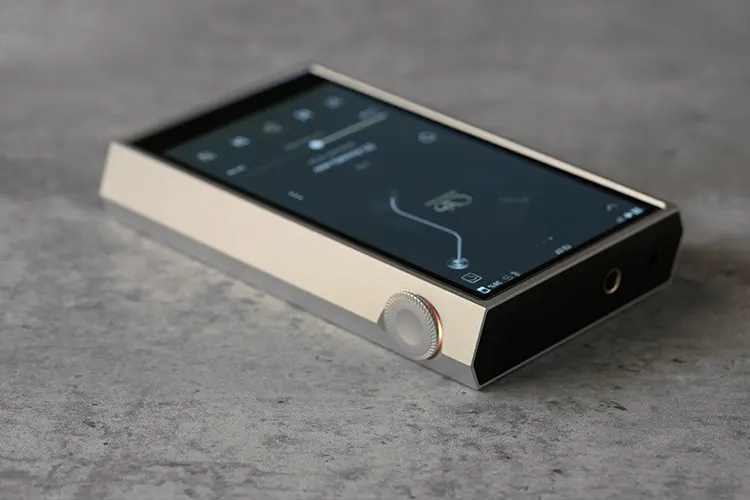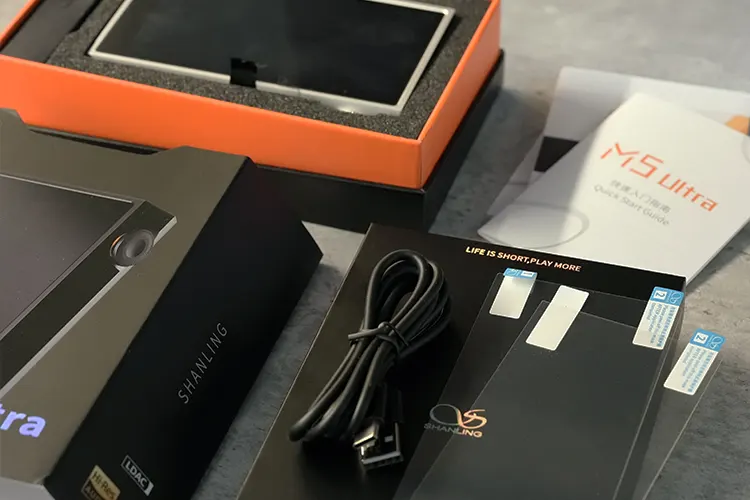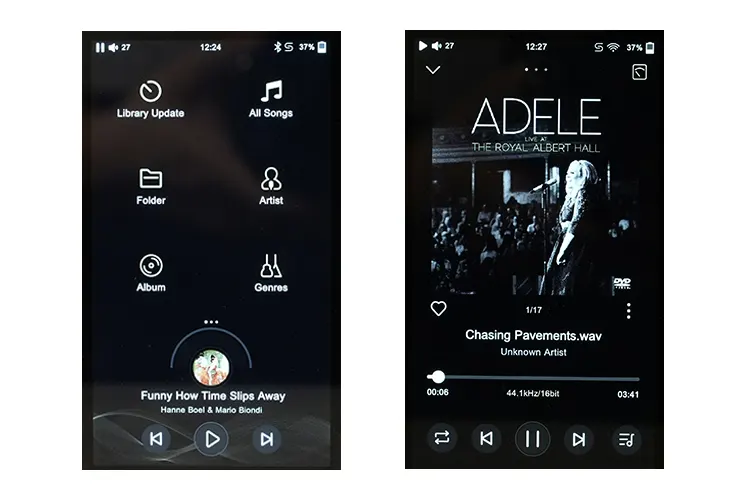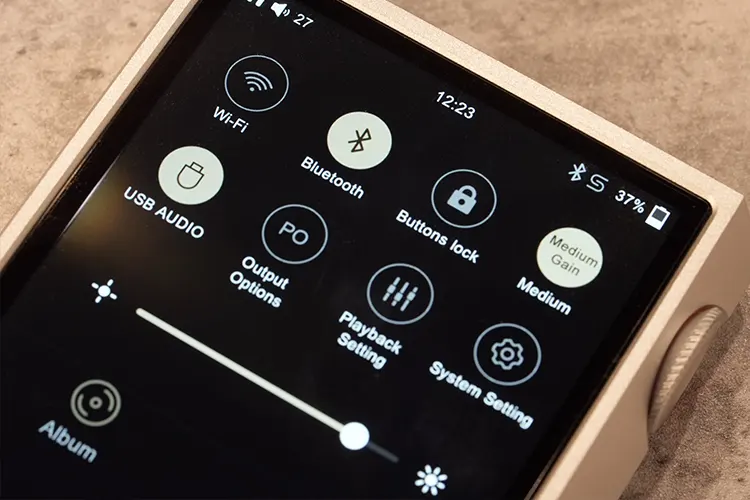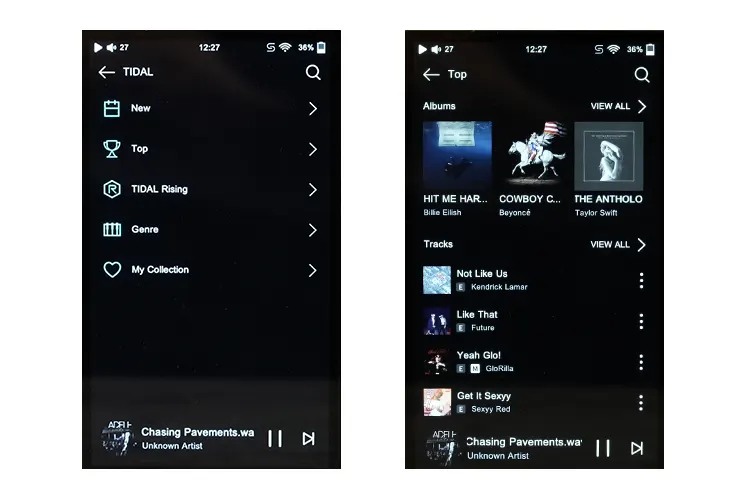In this feature, James reviews the $589 Shanling M5 Ultra, which is a new AK4499EX-equipped M-Touch system DAP capable of up to 1100mW of output power.
Disclaimer: This sample was sent to me in exchange for my honest opinion. Headfonics is an independent website with no affiliate links or status. I thank Shanling for their support.
To learn more about Shanling products we previously assessed on Headfonics click here.
Note, that this article follows our current scoring guidelines which you can read here.
At a time when most manufacturers are working on predominantly Android-based digital audio players and dongles, Shanling takes a different approach by returning to a pure music player design with the release of the M5 Ultra DAP priced at $589 SRP.
The player operates on Shanling’s lightweight Linux-based MTouch OS, catering to those who desire a simpler, music-focused experience.
Additionally, Shanling enhances the design with modernistic aesthetics. If you are curious whether the clean OS makes a night and day difference to the sound quality, continue reading my full review and comparisons below.
Features
Despite its mid-end positioning, the SHanloing M5 Ultra has an internal DAC chipset similar to Shanling’s more expensive but similarly configured H7 portable DAC and amplifier.
The M5 Ultra is equipped with premium hardware, including the flagship Asahi Kasei Microdevices AK4191EQ + AK4499EX DAC chips with FPGA-controlled oscillators. You will get decoding capability of up to PCM 32bit/768kHz as well as native DSD512 decoding.
With Texas Instruments TPA6120A2 op-amps also tucked inside the M5 Ultra it boasts a hefty output power rating of up to 1100mW with 32Ω loads in balanced mode. That will make it suitable for a wide range of planar headphones and high-impedance IEMs.
Shanling states that the audio circuitry and components bear a strong resemblance to the M9 Plus and is reflected in its tuning.
Design
The M5 Ultra design has a bit of an upgrade over the older models such as the M6. This is a more modern form factor with pronounced design lines, which I find cooler than their previous conservative approach.
However, on closer inspection, I can still spot some retained elements of previous legacy elements from its predecessors, such as the pattern on the knob.
The body ratio of the M5 Ultra feels quite similar to the M3X, with the jacks placed on the upper side. The rest of the design follows a minimalistic approach, featuring glowing lights around the knob and three rectangular navigation buttons on the left side of the body.
The build quality is good, boasting a smooth finish, and weighs only 247g, which is relatively light for DAPs of this size these days.
The 4.7″ 1280*720 screen with thin bezels looks sharp and is slightly recessed below the frame, providing additional protection if you choose not to use the leather case. I recommend you get the optional stitched leather case, which is thickly padded and complements the design beautifully.
I/O & Controls
On the top of the M5 Ultra, you’ll find 3.5mm and.4mm sockets which is pretty much standard. With many newer headphones terminating in 4.4mm plugs, you can directly connect them to the M5 Ultra, and you may be pleasantly surprised by its performance and power.
On the bottom of the device, you will find a USB-C port that allows you to connect to other devices and external storage via OTG. This provides added convenience for expanding storage or connecting to other compatible devices.
The touch screen on the M5 Ultra feels quite responsive with the Ingenic X2000 CPU providing adequate speed throughout the test.
The rectangular physical buttons allow you to control playback. The physical actions of the button clicks are clean, however, I find them slightly stiff to operate.
Synclink
The M5 Ultra supports Synclink connection via Bluetooth so you can use your iOS or Android device to control the device remotely similar to how the app works with the H5 or the H7.
This does not consume too much power and is easier to control on the phone while listening to locally stored music on the M5 Ultra.
Packaging & Accessories
Shanling has also revamped the packaging. Now it looks even more youthful compared to the previous reflective designs. In the box, you will find additional screen protectors, user manuals, and a USB-C to USB-A cable for using the M5 Ultra as a DAC for your PC.
Software Impressions
The M5 Ultra operates the in-house Linux-based MTouch 4.0 OS. The boot time is impressively quick, taking only a few seconds. The user interface of MTouch 4.0 has a strong resemblance to a customized Android OS. In particular, the drop-down menu is quite similar to Android.
One notable difference from common Android OS is that all the displayed icons on MTouch 4.0 are related to playback functions. Additionally, a playback control area at the bottom of the screen saves effort when adjusting settings or navigating through playlists.
In the playback screen, you’ll find some bonus features, including the ability to download album covers and lyrics. Furthermore, the M5 Ultra allows playback at different speeds, including 1X, 1.25X, 1.5X, and 2X, which could be useful for language or music learning.
Navigation
When using non-Android players the UI experience can always be a big concern. The UI on the M5 Ultra is designed to be pretty straightforward and intuitive since the navigation experience comes very close to using Android players.
Swiping actions are smooth and responsive, though you can’t swipe to the right to return to the last page which I hope Shanling considers enhancing. For the scroll-down menu, it would also be nicer if users could access the settings when holding a few seconds on the icons.
Tidal Support
When upgrading to the latest firmware the M5 Ultra has Tidal installed and you can quickly log in by scanning a QR code shown on the screen.
Next is simple; your usual playlists will be available so you can easily click to play or search for something new. The UI experience is quite stable and similar to the Android version so I do not perceive it will give owners any issues.
Media Management
With the in-house OS, the M5 Ultra operates very smoothly and scans the library rapidly. Tags are correctly read and you can access the tracks by Artists, Album or Genres straight from the desktop screen based on their tags.
Connectivity
Bluetooth
The M5 Ultra supports Bluetooth receiving and transmission. You can connect via the Synclink function to control the M5 Ultra on the phone which further enhances navigation.
Aside from these, DLNA and Airplay are also supported so you can connect to music servers and speakers or other devices supporting each service. This opens up possibilities for seamless streaming and playback from various sources, expanding the versatility of the M5 Ultra.
Measuring the Bluetooth signal strength from my phone around 5 meters apart the result is very positive. In practice, the connection is also stable throughout a few hours of listening with LDAC on the train.
USB-DAC
The M5 Ultra features the XMOS XU316 USB solution and you can directly plug it into your Windows or Mac PC and use it as a DAC without any driver needs.
The output quality and tonality in USB decoding mode are similar to when playing songs on board, and when the M5 Ultra is connected to a USB source it will also be charged.
USB-OTG
When plugging in a card reader the M5 Ultra successfully read it in 2 seconds. You can also choose to use the M5 Ultra as a USB audio source and select fixed or variable volume in the menu, so it can be paired with amplifiers that have no onboard volume control.
Sound Impressions
The M5 Ultra was given more than 100 hours of burn-in and tested with various pairings including the FiiO FT5, MOONDROP Venus, PARA, Westone Audio’s MACH 20 & 30, Shanling’s MG800, and the Earsonics SWITCH 300 PRO.
Summary
Venturing into the realm of mid-end pure music players without the extensive functionalities of Android-based players is indeed a bold move. However, the M5 Ultra manages to impress with its performance, particularly in terms of power and its organic presentation when paired with higher impedance loads.
The M5 Ultra delivers a remarkable level of power and richness in tone, all while maintaining a pleasing absence of unwanted sharpness with a dark, contrasting background.
It can drive high-impedance planar headphones and IEMs to sound engaging. The tuning of the M5 Ultra bears similarities to the M9 Plus, featuring a dense yet smoothly presented vocal body and an airy performance, which sounds more M-shaped.
Bass
When playing live music recordings, the M5 Ultra exhibits ample agility in the low end, delivering clean and textured kicks with a firm impact.
The sub-bass can be faintly heard as the bass is more prominent to give the vocal more weight. It offers a relaxing decay that effectively presents depth in the rendered soundscape and fills up the space while clearly outlining the bass elements.
Air and richness are abundant when it comes to acoustic guitar and bass drums. Also, lower vocal frequencies sound more authoritative than previous Shanling DAPs at a similar price point.
This works well for smaller ensembles and live music, and when more elements or faster kicks come into the mix it still performs fairly well and does not bleed over the mids.
Mids
Focusing on the mid-range frequencies, elements are well articulated and defined, with adequate speed in the mid-lows. The upper mids are elevated, contributing to control and separation power in the sound.
While maintaining good clarity and a slight touch of brightness that enhances vocal penetration, the very top of the spectrum is rounded off to eliminate sibilance.
Vocals possess a slightly softened and sweetened quality, which pairs well with J-Pop and K-Pop genres but may reduce some airiness in instrumentals. The vocals take a forward position, especially on higher gain settings, and when using IEMs, lower gain is preferred for better balance.
When testing the M5 Ultra with planar headphones, the vocal range is delivered smoothly, with a particular emphasis on energizing the 5kHz range to enhance vocal penetration power.
With higher gain settings, the vocals take a more forward position. The M5 Ultra excels in outlining the vocals with firm separation power, while still maintaining adequate speed in the bass region.
A commendable balance is achieved, preventing the upper mids from overshadowing the vocal body, which in turn empowers less powerful voices to stand out from the mix.
Treble
The upper frequencies are not as pronounced and exhibit a gentle roll-off. However, faint treble details can still be discerned in the background, avoiding a veiled or muffled sound presentation.
Transients are sufficiently captured in the treble but it is not pushed too prominent so the treble remains free from harshness.
Overall, the M5 Ultra delivers clear vocal frequencies with good brilliance and control, thanks to its powerful output. There is good energy in the treble which complements the slightly soft and relaxing bass, which gives a clear yet immersive response.
Staging & Dynamics
The M5 Ultra produces well-layered mid-lows with an elaborate decay, enhancing the perception of depth and height. The stage rendition is intimate, with the vocal taking the spotlight, yet it doesn’t feel curtained.
The overall level of detail and air is commendable, with percussion instruments clearly defined and the vocal image effectively separated from the backing, even with higher-impedance headphones.
On another note, with low gain, you may notice the output being softer, and with high gain it puts together a more defined and firmer image.
The energetic 5-6kHz frequencies on higher gain strengthen the treble transients and details, which works great when streaming live solos, jazz, and trending pop music on Tidal to sound lively and dynamic.
Click on page 2 below for my sound impressions, recommended pairings, and comparisons.




